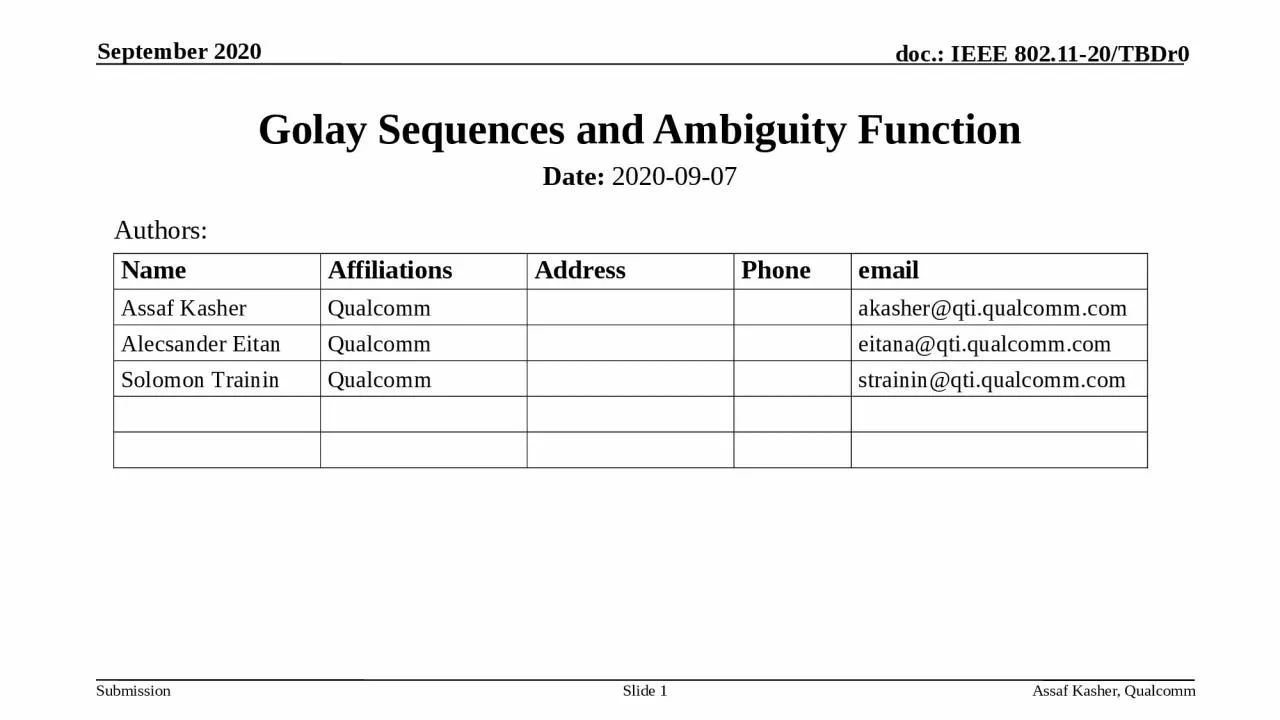

Date 20200907 September 2020 Assaf Kasher Qualcomm Slide 1 Authors Abstract This presentation discusses How Golay Sequences may be used for radar and sensing application and what their ambiguity function look like ID: 1007590
Download Presentation The PPT/PDF document "Golay Sequences and Ambiguity Function" is the property of its rightful owner. Permission is granted to download and print the materials on this web site for personal, non-commercial use only, and to display it on your personal computer provided you do not modify the materials and that you retain all copyright notices contained in the materials. By downloading content from our website, you accept the terms of this agreement.
1. Golay Sequences and Ambiguity FunctionDate: 2020-09-07September 2020Assaf Kasher, QualcommSlide 1Authors:
2. AbstractThis presentation discusses How Golay Sequences may be used for radar and sensing application and what their ambiguity function look like.Slide 2Assaf Kasher, QualcommSeptember 2020
3. Very Short Introduction to Golay Complementary SequencesGolay sequences are used in the DMG and EDGM clauses for detection sequences, channel estimation.Golay sequences come in pairs - The main advantage of using Golay sequences:There is a very efficient (log(n) additions) correlator that generates the correlations of both Ga and Gb Slide 3Assaf Kasher, QualcommSeptember 2020
4. How Can Golay sequences be used for Radar/SensingUse the CE sequences as it is in the DMG/EDMG subclauseMaximum Propagation delay limited to 128 samples (~10m)Allows usage of existing HWPossible Implementation: output of correlator (of both Ga and Gb) are summed with appropriate delay and sign changeTransmit Sequences separatelyAllows for longer propagation delay without overlapSome use of existing HWPossible Implementation: Correlator outputs are summed with the appropriate delaySeptember 2020Assaf Kasher, QualcommSlide 4
5. How does this fit in an EDMG PPDUThe sequences mentioned in the previous slide can be considered as modified TRN Units in an EDMG PPDU.Each sequence is a TRN-Unit, that may be transmitted in a different antenna setting (direction) Several PPDUs may be transmitted in different times to facilitate accurate doppler estimation.Slide 5Assaf Kasher, QualcommSeptember 2020
6. Performance of channel estimation versionThe upper figure shows the sum of 8 correlation with appropriate delays. We can see that there is a zero side lobes correlation zone of ±128 samples (±72ns)The lower figure shows an ‘ambiguity function’ with doppler shifts of ±300HzWe can see that there is a 90dB difference between the peak and the sidelobesIt is not possible to measure doppler shift in a single pulse using this sequenceThis a single Pulse Analysis, to find the speed of an object we need more than one pulseSeptember 2020Assaf Kasher, QualcommSlide 6
7. Separated Ga and GbThe figure shows a pseudo ambiguity function based on the sum of correlation with Ga and GbMaximum Doppler sidelobe ~90dB.Cannot detect doppler using a single pulse. September 2020Assaf Kasher, QualcommSlide 7
8. How can we estimate doppler using these sequencesThe figure shows a range-doppler map based on 64 pulse pairs Pulse pairs were separated by 100usecTo get accurate doppler results, super resolution methods are needed (MUSIC/ESPRIT).September 2020Assaf Kasher, QualcommSlide 8
9. ConclusionsGolay sequences are a good candidate for sensing applications, especially if they are already present within the design.The ambiguity function is probably not a good measure for sequence quality – it is measuring the ability of the sequence to enable both doppler and delay estimation in a single pulse. This is nearly impossible at the low speeds we are interested in due to phases noise between transmitter and receiver.Slide 9Assaf Kasher, QualcommSeptember 2020
10. ReferencesSlide 10Assaf Kasher, QualcommSeptember 2020